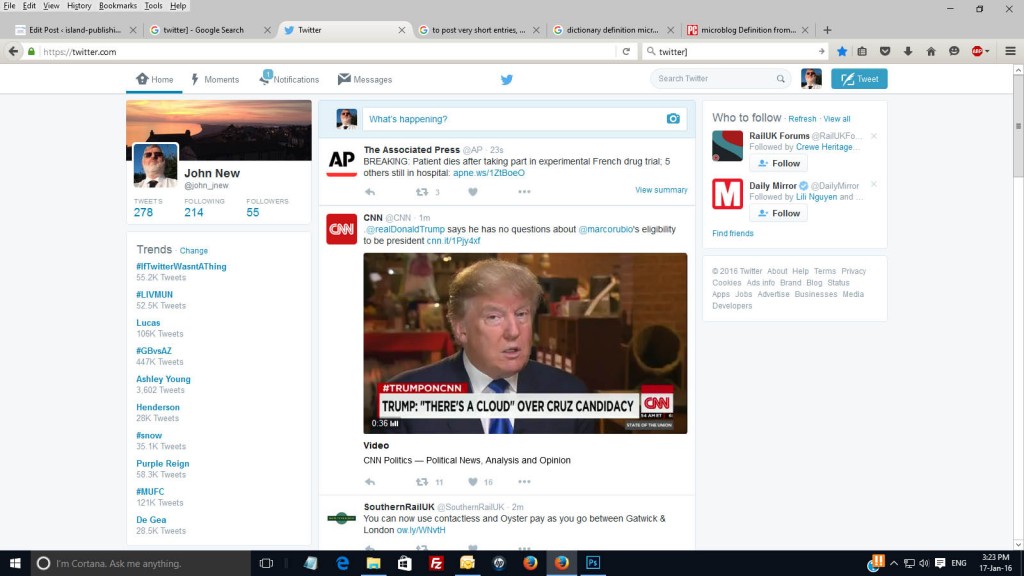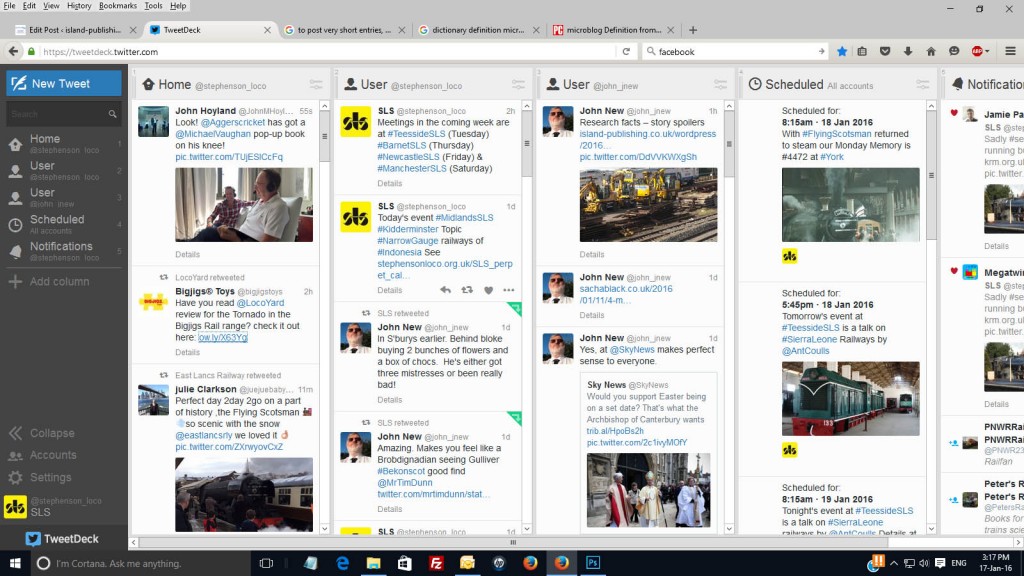
Micro-blogging with Twitter
Two years ago I didn’t tweet; now through micro-blogging, I do so on an almost daily basis, therefore a reflection is appropriate. This definition of a microblog from PCMag’s encyclopedia of terms undoubtedly describes how I use Twitter;
“A blog that contains brief entries about the daily activities of an individual or company. Created to keep friends, colleagues and customers up-to-date, small images may be included as well as brief audio and video clips. The most popular microblogs are Twitter and Tumblr.”
Pre-conceptions -v- reality
Before I began to use Twitter my preconception was that a lot of the content was shallow froth regarding show-business celebrities and/or pointless announcements regarding people’s mood or whereabouts. Since becoming a tweeter, I have found that there is far more serious content circulating than I anticipated. However, especially with the more conversational element, that pre-expectation was also confirmed.
Micro-blogging – the way I use Twitter
I have three accounts, the first in my own name, a second on behalf of the Stephenson Locomotive Society and a third (the alias Graham Crosse) created in 2015 to write about the election, and currently only used infrequently. The style varies between the three, with the posts undertaken for the SLS the most formal.

Screengrab – Twitter
Open debate versus secrecy
The fact that I am able to have a Twitter alias, however, is one of the areas within social media open for debate. I created my alias because I was working as a Presiding Officer during the 2015 election and therefore I had to be seen publicly as neutral, whilst at the same time working on a 2nd year University project requiring publication of comments on election related politics. As I have accepted the offer to work on the local elections this year, the same scenario will again arise around election time; the alias will therefore get a further, short-term, revival.
There are many more serious reasons for individuals to create aliases than mine. However, the ability to post without the user openly revealing a true identity can be seen as both a positive and negative aspect. It can protect individuals and allow them to openly enter debates on issues where fear and security concerns would otherwise preclude their participation. The converse scenario, of course, is that this anonymity allows bullying and inappropriate comment, for example on race or sexuality, to be aired by individuals hiding anonymously behind an on-line alias.
In a journalism-related reflection, this issue needs to be debated. On balance the freedom of speech enabled by allowing use of alias user names is undoubtedly beneficial, but the level of censorship levied by host providers and/or governments is a concern in many areas, notably North Korea and China.
In the opening paragraph, I mentioned my preconception of the twittersphere as being filled with shallow froth; whilst that may be a harsh condemnation, experience confirms that there is a percentage of conversational traffic which is only relevant for the very short-term. If you enter those conversations, anything more substantial within your twitter feed soon drops away and disappears. In my own case, when posting for the SLS, this knocks meeting announcements etc., off our displayed Twitter feed, even though joining in conversations and making retweets would otherwise be appropriate.
Aliases of course offer the option of running two feeds, one for casual matters, one for tweets you may want to display, for example on a website news page, but that complicates matters. The complication arises for both content creators, and also recipients wishing to return to a viewed message. Twitter is a useful tool, but a management nightmare, even with the assistance of options such as lists and tools such as Tweetdeck to aid managing the content.

Tweetdeck screen grab
Summary
Twitter as a tool is an enigma. Whether as merely a citizen wishing to know what is going on, for example “is my train going to be delayed”, or as a journalist/reporter wanting to keep abreast of breaking events, it is extremely useful.
It is also invaluable for following the latest information on a topic of interest to you. The lists option, especially if a list management tool is used, aids grouping of content feeds but equally Twitter is a frustrating option for managing the dissemination of information. For the Society I find it has a greater reach than Facebook and, despite the problems of managing it for the SLS, I have come to rely on it over the last eighteen months as a source of information. I will not be reducing, or abandoning, my use of it in the foreseeable future.
———————————————————–
